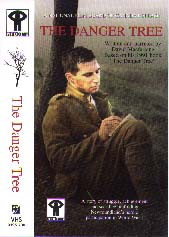|
________________
CM . . . .
Volume V Number 4 . . . . October 16, 1998
David Macfarlane narrates this story, from his 1991 book of the
same name, about Josiah and Louisa Goodyear and their seven
children, six boys and one girl. In 1907, they move from a
traditional fishing life to Grand Falls, a paper town. Then the
Great War occurs, and five of the six Goodyear boys join the
regiment contributed by the colony of Newfoundland. Their
personal story is run in tandem with the story of Newfoundland, a
British colony, and its tremendous sacrifice during the Great
War, its subsequent bankruptcy, and a narrow vote (51%-49%) to
join the country of Canada.
At a time when Saving Private Ryan is in theatres, the theme of
many sons from the same family going off to war is a familiar one
and should appeal to teens. This is a true tale, and three
Goodyear boys, Ray, Stan, and Hedley, never return to their
homes. Our Canadian history is clearly not the history of
Newfoundland, and this video, by offering insight into an area
that is not often covered in the classroom, is appealing on that
score as well. The closeness of the vote bringing Newfoundland
into Confederation should ring bells and provide all sorts of
classroom discussion about the latest vote in Quebec to separate
and the ensuing court decisions and battles.
The filming of this video is truly inspired. The combining of
black and white films from World War I with current reenactments
is done seamlessly. The use of black and white stills that fade
into the present scenery of Newfoundland is also masterfully
done. The changes from colour to black and white, old reels to
new is never intrusive or jarring. The move from memory to the
present via the narration is not always as smooth. David
Macfarlane has a wonderful reading voice and makes a good
narrator. The fact that the story is a personal one makes the
voice tones even better. The one flaw is in the voices of the
"memories". When Macfarlane discusses his great-grandmother's
point of view, a female voice fades in and out to make the point.
This also happens with all of his other characters. What they
say is interesting and pertinent, as is the vintage music that
sometimes accompanies their words. The problem is in the voice
quality and the sound level. These voices are sometimes difficult
to distinguish, necessitating continuous volume adjustment, which
may be difficult in the classroom.
That one flaw aside, this is a wonderful video for teachers
looking for an alternate view to the usual in teaching about
Canada and World War I. It would also be interesting for classes
researching family histories or the histories of the separate
provinces of Canada. The Newfoundland referendum of 1949 also
contains much material of pertinence to today's Canadian history
classrooms. This video is also just plain entertaining, and the
viewer comes to identify with this family and with the country of
Newfoundland, both of which gave up so much.
Highly recommended.
Katie Cook is a social studies teacher and a teacher-librarian at
the Steinbach Regional Secondary School in Steinbach, Manitoba.
To comment on this title or this review, send mail to cm@umanitoba.ca.
Copyright © the Manitoba Library Association.
Reproduction for personal use is permitted only if this copyright notice
is maintained. Any other reproduction is prohibited without
permission.
Published by
TABLE OF CONTENTS FOR THIS ISSUE - OCTOBER 16, 1998.
AUTHORS |
TITLES |
MEDIA REVIEWS |
PROFILES |
BACK ISSUES |
SEARCH |
CMARCHIVE |
HOME
|

